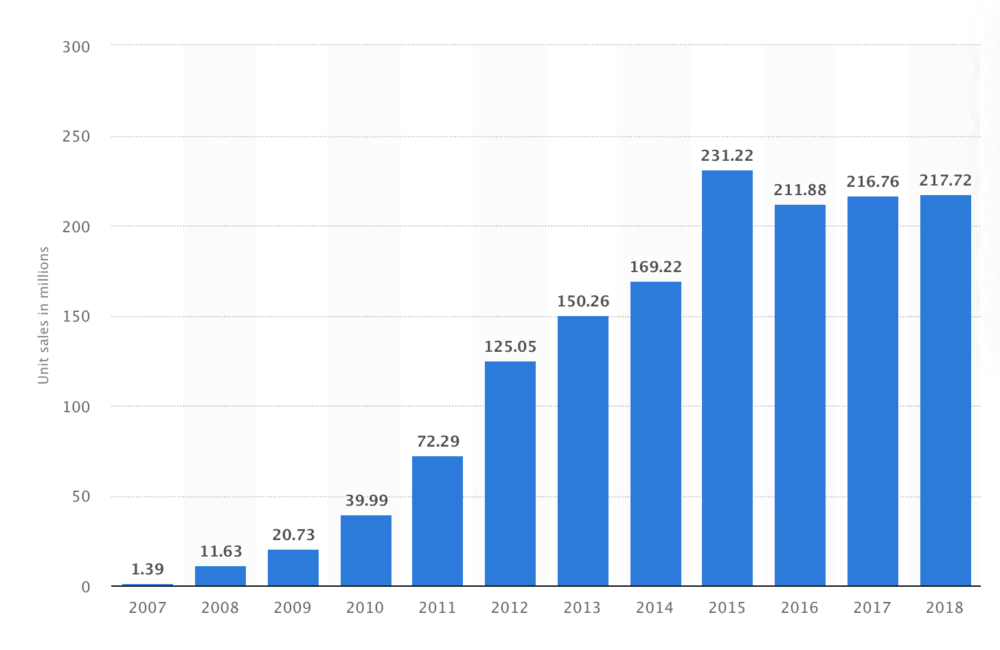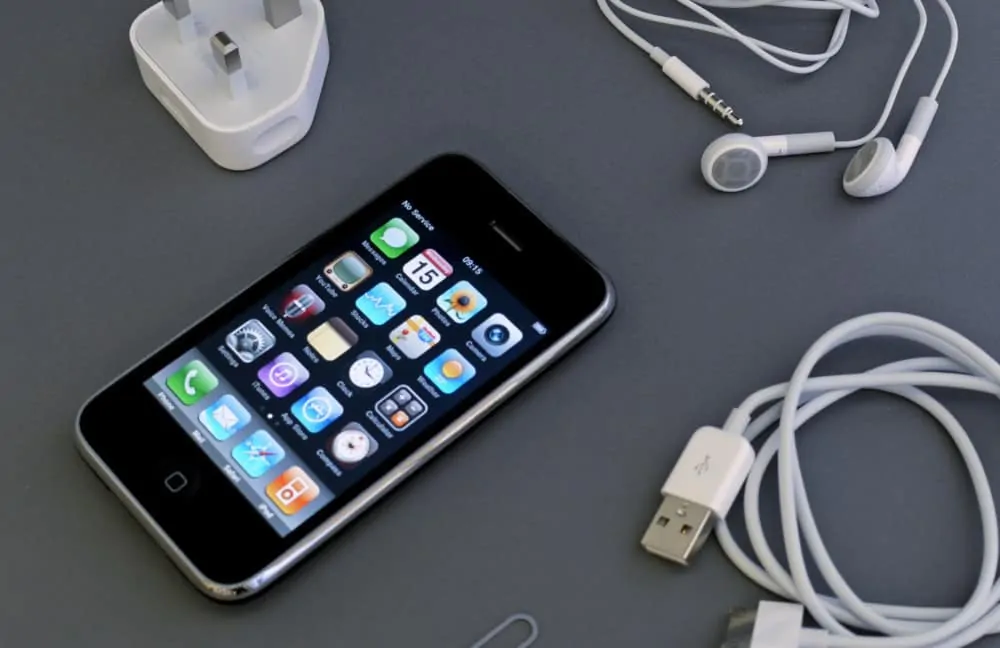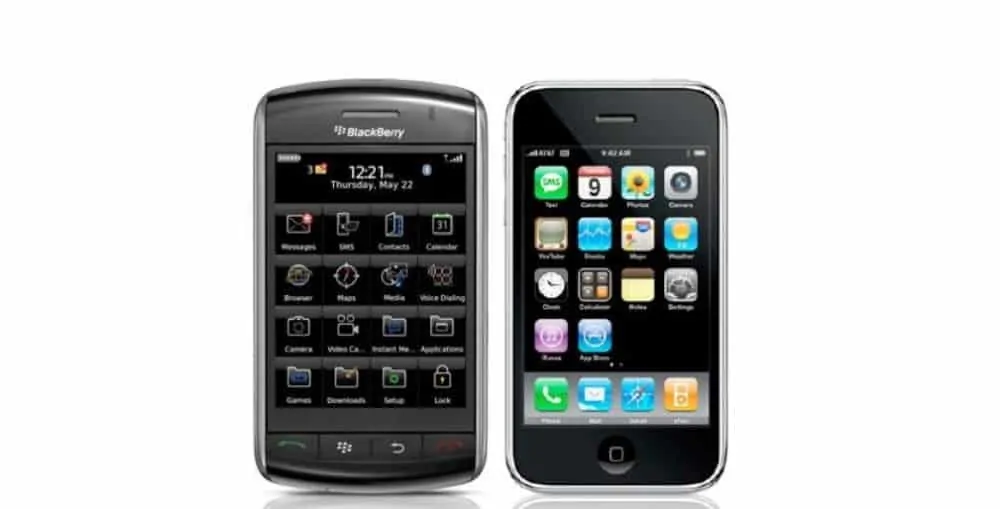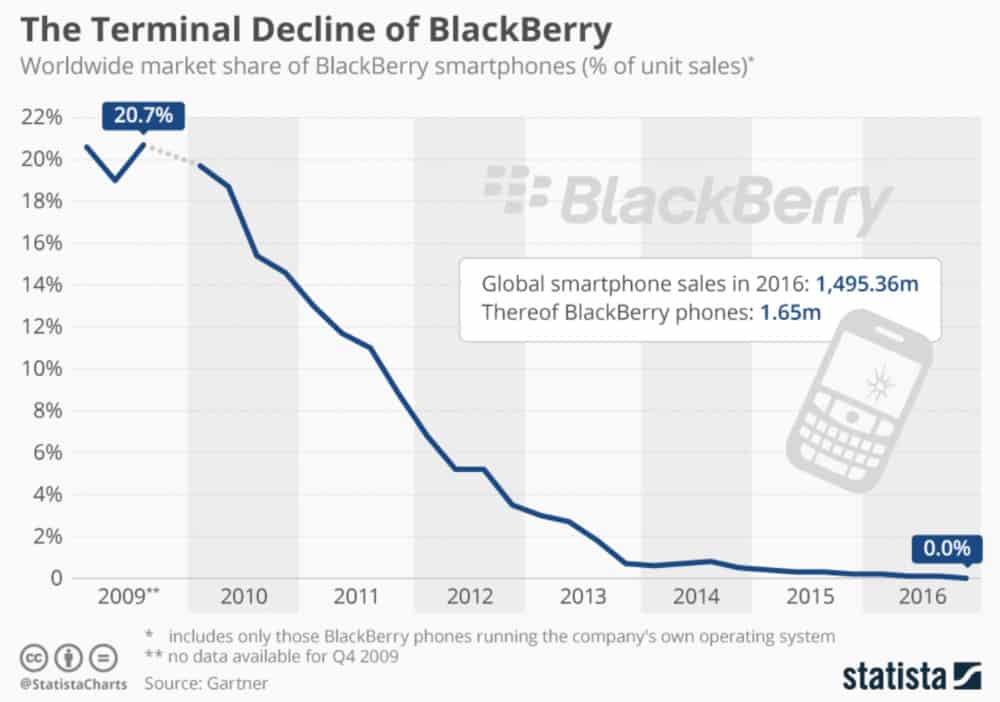Once the fastest-growing company on earth and the biggest phone maker on the planet, BlackBerry’s fall from grace was one of the biggest nosedives by a phone brand in smartphone history…
In the not too distant past, before Android and iPhones, BlackBerry was king of the phone market. In 2009, it was once named as one of the fastest-growing companies on the planet and, just 11 years later, it no longer even makes phones. So what the hell happened? How did a company as innovative and important as BlackBerry fail?
In order to answer that question properly, we first need to look back at what was happening in the market when BlackBerry first started to gain traction. It was a markedly different place back then. We didn’t have iPhones and we didn’t have Android phones. Hell, we didn’t even have smartphones. And this is where BlackBerry got its start.
From 1984 To The First BlackBerry Phone
BlackBerry was originally founded in 1984. Called Research In Motion (RIM), the company specialized in modems and pagers. During this period of time, RIM secured a number of patents, developed technologies (push email, for instance), and began amassing a legion of developers and creative minds to help push it forwards.
In 2000, BlackBerry released its first mobile phone, the BlackBerry 957. And its big draw was that it was internet-connected, totally secure, AND it could do push email. The BlackBerry 957 quickly became the darling of corporate America, thanks to its rock-solid encryption and ability to email (and, therefore, work) on the go and at home.
The Dawn of The Crackberry…
From 2000 onwards, BlackBerry released a slew of phones, each building on from the last, adding in new features, improved specs, and better technology. The company’s presence grew, mostly powered by businesses looking to improve the productivity of their workforces, and by the close of the mid-2000s, BlackBerry was not only the biggest phone brand on the planet but it was also one of the fastest-growing businesses on the market.
In 2009, BlackBerry was named the fastest-growing business on the planet. “Thanks to a big rise in the popularity of its Blackberry handsets,” noted the BBC, “profits at RIM have grown 84% over the past three years, while its revenues have expanded 77%, and it has seen a total return of 45%.” During the same period of time, Apple was ranked 39th and Google 68th.
In the mid-2000s, BlackBerry essentially brought on-the-go-email to the masses. Prior to this, you needed to be at a work station or on your laptop. Other phones did do email. But not quite as well as BlackBerry, as RIM really dived deep on the BlackBerry’s email capabilities in order to make it the benchmark by which all other mobile devices were compared.
Helped in no small part by the fact that ALL BlackBerry phones had physical QWERTY keyboards, RIM’s mobile business grew and grew, dwarfing its competitors and making brands like Nokia fret about their market share. And most of RIM’s initial surge in growth was powered by business users. Once BlackBerry started going after consumers too, things really started to take off…
Take this report from GFK in 2010: BlackBerry handsets accounted for 28.2% of all smartphone sales in 2010. On top of this, RIM also managed to gain 36% of the Christmas sales, with over 500,000 sales for the period. During this time, RIM’s BlackBerry App World also grew 500% year on year, although it still only had around 17,000 apps (more on this later, though).
The Celeb Factor
RIM’s brand was helped in no small way by a slew of celebrities, including Barack Obama and Kim Kardashian, that helped propel the appeal of BlackBerry phones to an even wider audience of users. By this point, RIM had phones in every price segment – from cheap and affordable phones to more premium, flagship models.
But the key with BlackBerry phones, back then, was that they all delivered the same software and features. They all had BBM, the handset’s #1 reason for its rise in popularity with teenagers, and they all ran the same email and messaging applications. This was the thing that made BlackBerry phones quintessentially BlackBerry.
And you couldn’t get it anywhere else. If you wanted to chat with your friends on BBM, you needed a BlackBerry. If you couldn’t afford an iPhone, but you wanted internet access and email, you needed a BlackBerry. And, if you were lucky enough to have a job that scored you a free phone from 2000 to 2009, chances are it would be a BlackBerry.
With all of the above in mind, it is easy to see how BlackBerry became the dominant brand in the mobile phone space during the first decade of the 21set century. It has business appeal and consumer appeal, it was loved by presidents and teenagers in equal measure, and, unlike iPhone, it wasn’t prohibitively expensive to acquire one – even if you were a student.
The iPhone
Apple released its first iPhone way back in 2007. Back then, Apple was not the company it is today. Still reeling from its terrible performance in the 1990s, Apple was very much an outsider at this point. It had big success with the iPod, but its computer business was still playing second fiddle to Microsoft’s Windows. And its phones were completely untested in the wild.
Initially, growth was slow. Helped in part by the cost of the iPhone; it was more expensive than everything else on the market. But Apple was playing the long game here, it knew what it wanted to do and, having the experience it had with iTunes and iPods, it knew just how to execute a plan that would make it a major player in the rapidly growing mobile space.

In 2007, the iPhone was nothing (see table above). It had no market share and it cost too much for people to buy. But this wasn’t the point. Apple’s vision was one that was completely different from anything that came before it – it wanted to create an ecosystem around the iPhone, just as it had done with the iPod. It knew that would take time, but it also knew the benefits would be enormous once growth started to happen.
Apple’s plan was simple: build an App Store, build a legion of developers, create a simple but completely different style of phone, and wait for consumers to wake up and realize what they’re missing out on. It didn’t take long for Apple’s iPhone to start gaining traction either. In 2007, it sold 1.4 million iPhones. By 2011, it was shifting 72.2 million iPhones per year, according to market watchers.
The Reinvention of The Mobile Phone
The release of the iPhone, as well as the first Android phones, was the first shot across BlackBerry’s bow. RIM was apparently taken aback by Apple’s first iPhone, and this shock was mostly down to Apple’s design choices – the phone was practically all-screen compared to RIM’s BlackBerry devices. RIM engineers were confident this would be Apple’s downfall, as the power requirements would be too great.
But that was Apple’s ace in the hole. It not only nailed the concept of the first iPhone, popularising touchscreen phones over phones with physical keys like the BlackBerry Touch and BlackBerry Bold, but it also got the ball rolling on an entirely new mobile platform that was build from the ground up to take over the entire market. Meanwhile, RIM was confident that people did not want to give up their QWERTY keyboards.
Bur RIM was wrong. And for me, this was the first chink in BlackBerry’s fall from grace. It failed to see where the market was going and didn’t do enough to create an ecosystem around its products when it had the chance. Apple knew this, and so too did Google, which is why when iPhone and Android launched, they were supported by robust ecosystems that were geared towards developers.

Apple and Google knew that apps were the future of phones. Applications and games would be the things that drove adoption and sales, not things like email and security which was RIM’s only real marketing angle at the time. Both of these things were important, obviously, but Apple and Google showed customers that there were other things you could do with phones – fun things that didn’t involve work!
Interestingly, it was during this era that I first started working in the mobile tech industry. It was a strange time compared to now. Nokia and BlackBerry were dominant and Google and Apple were the upstarts, the untested platforms vying for the hearts and minds of consumers. Even back then, I remember thinking: why would I want a phone with buttons when I could have one like the iPhone?
I couldn’t afford an iPhone back then, of course, but this is where Android starts to play a roll in our story. Conceptually, Apple and Google had the same idea for their phone businesses, they just went about it in a completely different manner; Apple wanted to control everything and Google took a more open-source approach to Android, letting its OEM partners do the heavy lifting. Either way, both elements combined (apps and touchscreen phones) were the seeds of BlackBerry’s impending destruction.
The Touchscreen Phone is Here To Stay
BlackBerry attempted to counter the rise of Android and iPhone with the release of its first touchscreen device, the BlackBerry Storm. It was panned critically and sales were iffy at best. And to make matters worse, the handset had major issues with its touchscreen which resulted in Verizon having to replace almost one million units to the tune of $500 million in losses.
There was a sequel, the BlackBerry Storm 2, but, again, this phone failed to impress reviewers and consumers. And this spelled the end of BlackBerry’s Storm line-up of smartphones. But it wasn’t the end of BlackBerry’s foray into touchscreen phones. Between 2012 and 2014, BlackBerry continued releasing phones, powered by its BBX platform, although its focus returned to handsets with QWERTY keyboards, though some of its releases also featured touchscreens too.

The best of both worlds? Hardly. By now, Apple’s brand and the idea of the touchscreen phone had become the driving force in the mobile space. Consumer electronic brands like LG, Samsung, Sony, and HTC were leveraging Google’s Android platform and creating compelling alternatives to both Apple’s iPhone and, of course, RIM’s BlackBerry phones. And I think it was this exact point when RIM reached its point of no return…
Working in London, I remember seeing more and more iPhones and Android phones in the hands of people on the street, whereas before everybody had had BlackBerry phones. It didn’t happen overnight, but you could see it happening. The tide had shifted in favor of Apple and Google’s way of doing phones. People not only wanted touchscreen phones, but they would go out of their way to buy them. And if they couldn’t afford and iPhone, they’d get an Android phone.
BlackBerry stopped becoming an option. The brand became stale. People viewed BlackBerry phones as stuffy relics from a bygone era. And this was in 2012, a time when BlackBerry was still a dominant force in the phone world. But the writing was very much on the wall at this point, the concept of what a phone was had changed, and BlackBerry, although it had helped birth the modern smartphone, no longer seemed to have a role in the consumer market.
The Four Things That (Most Likely) Killed BlackBerry
- The BlackBerry Operating System – BlackBerry’s OS helped BlackBerry grow massively in the early 2000s but when iOS and Android came along, it ended up being the rope around its neck. It didn’t support apps like iPhone and Android, it looked and felt clunky to use, and it was still married to the QWERTY keyboard when the rest of the world had well and truly moved on.
- Too Much Focus on Enterprise – All RIM cared about was enterprise users. It knew they were its bread and butter, but even when BlackBerry was dominant very little effort was made to attack the consumer market. There were successes, yes, but RIM did nothing to lock consumers into its platform, a thing both Apple and Google did very well from the very beginning.
- The App Store Was Appalling – The iPhone and Android reinvented how users interacted with phones. But they also changed what users do with their phones too. Third-party applications drove adoption and created entire industries from nothing overnight. BlackBerry failed to act once again. Its App Store was appalling, even when compared to the early builds of Apple’s App Store and Google’s Android Market; BlackBerry App World has just 17,000 applications at its peak.
- Too Late With Innovation – At the height of its fame, RIM was a huge force in the technology world. During this period, RIM should have begun using its MASSIVE profits to develop a coherent strategy for going after the consumer market and locking them down. It should have seen where the market was going and started work on BB10 then, not once the horse had bolted.
BBM & Switching To Android Too Late
Once RIM’s fall was in motion, it quickly became evident that it was unstoppable. In the space of a few short years (2010 to 2012, BlackBerry’s market share dipped from 20% to less than 6%, a massive loss which resulted in the company hemorrhaging cash and laying off staff. By this point, the ONLY thing RIM had going for it was BBM, the company’s ultra-popular IM app.
It’s always easy, with hindsight, to look back on things and say, so and so should have done this. Had they done that, they’d probably have been OK. But with BBM, I just cannot understand why RIM didn’t start rolling it out to iPhone and Android. Back then we didn’t have WhatsApp, so getting the most popular IM in the world onto iPhone and Android would have proved very successful – everybody would have used it!
Could this have stopped WhatsApp in its tracks? Maybe. At the time millions of people used BBM. Adding it to iPhone and Android would have doubled that number within months, allowing non-BlackBerry users to message their buddies with BlackBerry phones. RIM could have taken its brightest asset and used it to leverage Google and Apple’s audience for its own gain. But instead, it decided to lock BBM to BlackBerry in the hope that A) no one else would invent a free IM app, and B) that people would buy BlackBerry phones solely to use BBM.
Fast forward to 2014, and WhatsApp’s two founders sold their IM app to Facebook for $19 billion. It makes you think, right? If WhatsApp was worth $19 billion, what could BBM have been worth if BlackBerry had ported it to Android and iPhone in 2008/09 and focussed on growing it into the world’s #1 IM app? Probably not $19 billion, but it does make you think how things could have turned out had RIM been more “open-source” with its most popular tool.
The End of Times (For BlackBerry)
I went to the launch of BlackBerry 10 in Florida. Lewis Hamilton was there and so too was Alicia Keyes. By this point, however, even they had switched to iPhone, despite being (paid) brand advocates of BlackBerry. I won’t go into too much detail about BB10, other than to say it was a magnificent operating system that could have taken over the world had BlackBerry launched in 2007 instead of 2013.
Powered by QNX, BB10 was a super-powerful operating system with buckets of potential. It was just too late. By 2013, Apple and Google controlled the phone market. No one else got a look in. You either bought and iPhone from Apple or you got an Android phone from one of Google’s ever-growing list of hardware partners.

BB10, while impressive and hugely innovative, was just too late. You cannot come to a party at 3 am in the morning, stone-cold sober, and expect everybody to calm down and wait for you to get your buzz on. But this is exactly was BlackBerry did with BB10. Had it launched BB10 in 2008/09, I have no doubt that things might have been different. I say, might, because RIM doesn’t exactly have a good track record when it comes to winning over the hearts and minds of consumers.
But back then, it knew what Apple and Google were planning. It could have used its massive resources to create its own consumer-facing ecosystem packed full of third-party applications and games. Had it done this, rather than ignoring the rising threat of robust app stores and touchscreen phones, things might have been different. But it didn’t and in the end, in what might be considered the ultimate insult, BlackBerry was forced to adopt Android before it completely disappeared into oblivion…



